CHAPTER 1
Setting Up
Let’s say you want to go on a road trip—cross-country! You’ll need a reliable car and a tank full of gas. You’ll want a map you can trust, some time, patience, and a good playlist.
Now, let’s say the road trip is actually a cooking journey. The car is your kitchen, and that tank of gas is your kitchen tool kit. And the trusty map? This chapter. Here, you’ll find the crop of tools needed for nearly any recipe, plus the essentials for serving and enjoying what you cook (and saving it for later). As we get on our way, outfitting the kitchen little by little, we hope you’ll add your own handy favorites and feel ready to take on the road.
USE THIS CHAPTER

To Assemble Your Kitchen’s All-Star Team
Your Tools
When it comes to picking tools, we like to balance super-utilitarian with super-lovely. Tools that’ll last forever, feel good in hand, and wink at us from the shelf or drawer? That’s the stuff that has our name all over it. With kitchen tools, having fewer, higher-quality pieces is better than having too many unitaskers or special-occasion items that we don’t reach for often. These go-tos will make cooking a heck of a lot easier—and more fun.
Tools fall into a few categories: for snipping, slicing, and mixing (knives, small appliances, handheld tools, and the like); for cooking, baking, and other kitchen wizardry (pots and pans and bakeware); and for serving, sharing, and nibbling (what the eating happens on). In each category, you’ll find the Must-Haves that we couldn’t cook without; you’ll also find the Nice-to-Haves that broaden our kitchen’s horizons (or simply speed up dinner). But it’s not all work. We also call out the “tools” whose main job is to make you smile. That’s a big part of being in the kitchen!

 FOR SNIPPING, SLICING & MIXING
FOR SNIPPING, SLICING & MIXING
Knives: Making the Cut
A great knife can help you whip up just about anything—a shaved salad, a spatchcocked chicken, a hearty hash, and beyond. You’ll use it more than any other tool. In general, we recommend knives with a solid, weighty stainless-steel or carbon-steel blade and a handle that feels nice in hand, whether plastic or wood. We’re here to help you pick the right shapes and sizes for your cooking. (Psst: Check out Your Kitchen Cheat Sheet on this page for any measurement conversions you may need.)
Must-Haves

-
Chef’s knife: A true workhorse, this large knife has a broad, sharp blade for doing a whole mess of kitchen tasks. Choose between a Western-style chef’s knife (with a slightly curved edge) and a Japanese-style santoku knife (a bit thinner, with a flat edge). We find 8- to 10-inch blades to be the most versatile.
-
Kitchen shears: These can break down a raw chicken, snip fresh herbs, cut up a pizza, and lots more. Bonus points for blades that come apart for thorough cleaning.
-
Knife block, magnetic rack, or blade covers: Instead of sticking knives straight into the drawer, where they’ll quickly dull, consider using a countertop knife block or wall-mounted magnetic rack. If you do like your knives drawer-side (maybe you want them well out of the way of young kids or a rascally pet cat), try an in-drawer knife organizer or hardy blade covers. These helpers will protect your knives and you.
-
Paring knife: Small, sharp, and light, this little one (3 to 5 inches!) is all about the details—hulling strawberries, scoring pie dough, deveining shrimp, and more.
-
Serrated knife: This sturdy blade with small serrated grooves won’t hesitate against a crisp crust, a tender tomato, or a delicate-crumbed cake. Go for one 10 inches long.
Nice-to-Haves

-
Cleaver: A definite for at-home butchers. Look for one with a heavy handle and blade.
-
Honing steel and/or whetstone: Sharp knives are safe knives, thanks to regular care. A honing steel realigns the “teeth” of the knife to help spruce up your blade in the short term, while a whetstone will give you a true sharpening. (If you don’t have either of these, keep your friendly neighborhood knife sharpener—or hardware store—on speed dial.)
-
Mini serrated knife: This 4½-incher is an ace for soft fruits, like peaches, stubborn-skinned citrus, or a log of frozen cookie dough.
WHERE IN THE WORLD IS MY KNIFE FROM?
Many countries are known for their knife craftsmanship, but the knives you’ll see most often are German and Japanese. German knives are made of a thicker, softer steel than Japanese knives, which are made of a hard, thin, brittle steel that requires skilled sharpening. For an all-purpose or beginner’s knife, go German. If you’re an experienced cook with a trusted sharpener (or can sharpen yourself), go Japanese.

Cutting Boards: Join the Block Party
Almost all good cooking starts with honest chopping and slicing on a cutting board. We gravitate toward models without extra bells and whistles and keep a range of sizes: at least two large ones (12 by 18 inches, minimum) for most big jobs, and a little one (say, 6 by 8 inches) for cutting up a quick snack. (Psst: Check out Your Kitchen Cheat Sheet on this page for any measurement conversions you may need.)
Our Faves

-
Wooden or bamboo boards: These go-tos are easy on knives and on the eyes, though they can be an investment and require some regular care. You can’t go wrong with solid maple boards, but eco-friendly bamboo boards are a little friendlier on the wallet.
-
Plastic boards: These are cheap, easy to clean, and kind to your knives; we always have a stack of them and love being able to throw ’em in the dishwasher after a particularly messy job. We prefer shock-absorbing solid plastic boards to flexible plastic sheets, which are less sturdy and more difficult to chop on comfortably.
-
Wooden butcher block: If you have the space and budget, an extra-large (around 24 by 18 inches) and thick (1½ inches) chopping block is a handsome, near-indestructible statement piece. Whether a stand-alone block or part of your countertop, these get special designation. We love them for all the reasons we love wooden boards—looks, durability, and friendliness to knives. If you’re able to budget a bit more for one of these beauts, you’ll be amply rewarded.
No-Ways

-
Glass, slate, and marble boards: They might look pretty, but cutting on them is like buying an express ticket to Dull Knife City. Save these for serving (hello, bountiful cheese plate!) instead.
WHAT IF I’M CUTTING MEAT?
Contrary to what you might have heard, plastic and wooden boards are equally good for meat. Wood is naturally antimicrobial (cool!) and, of course, is nice to look at—though plastic is easier to clean in the dishwasher. Regardless, if you cook meat often, keep one dedicated, durable board that you can consistently put through the cleaning wringer (see this page to learn how to remove any stains or smells that come your board’s way).
The Cutting Board Our Community Helped Make

When we were designing our own dream cutting board for our Five Two line, we asked 10,000 home cooks about their essential features. Boy, did they have some great ideas.

They love a large, durable board with ample room for chopping…
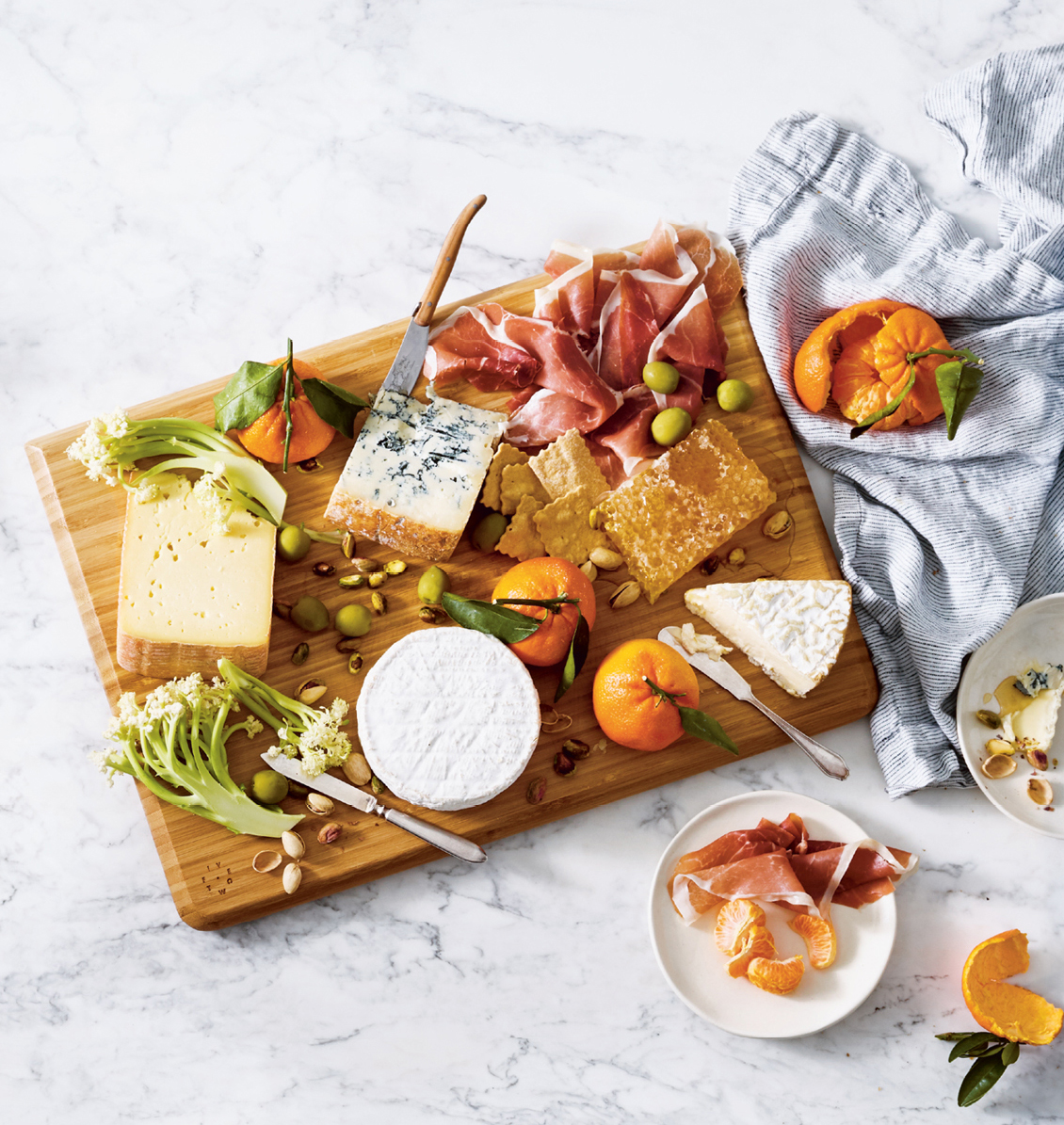
…that’s handsome enough to moonlight as a serving platter…
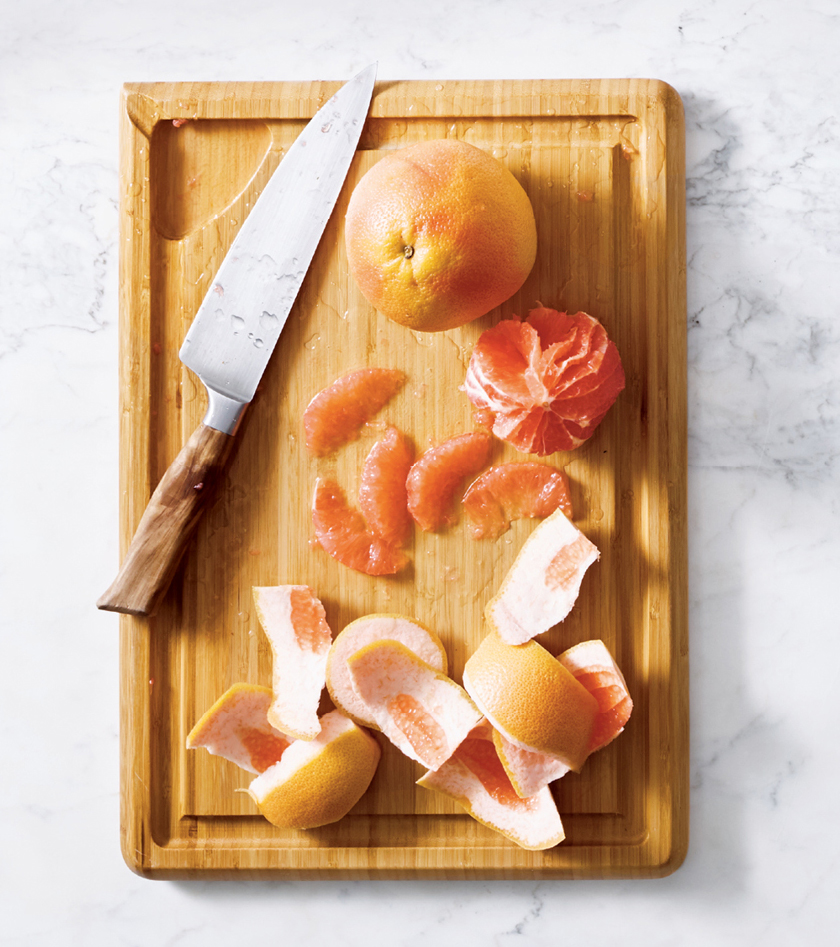
…with a deep juice-catching groove on one side (and a smooth reverse)…

…that’s easy to lift (phew).
Small Appliances: The Magic Makers
These little machines are where so much of the transformation happens in the kitchen—but for most of your cooking, you’ll just need a few things. Here are the zippers, zappers, and whirlers that earn their keep in our homes—and still leave our countertops uncluttered. (Psst: Check out Your Kitchen Cheat Sheet on this page for any measurement conversions you may need.)
Must-Haves

-
Stand or handheld electric mixer: If you’re a baker, your mixer is practically an extension of your body. Spring for a stand mixer (like the classic, near-synonymous KitchenAid) or go for the smaller, budget-friendlier hand mixer (which can’t do quite everything a stand mixer can but makes light work of mixing and whipping all the same).
-
Food processor: The giver of hummus, pesto, and quick-shredded cheese or vegetables—we love this machine and want to shout it from the rooftops! Pick one that has a capacity of at least 10 cups and comes with an all-purpose blade, a feeding tube, and a detachable shredding disc accessory that usually accompanies new models.
-
Caffeine machine (and accessories) of choice: Teapot? French press? Auto-drip? Burr grinder? Buy whatever you need to get your fix.
Nice-to-Haves

-
Blender: A food processor can do much of the work of a blender—but a blender really is king for liquids. Go for one with a capacity of at least 56 ounces; buy a high-powered version if you’re a smoothie aficionado.
-
Immersion blender: Great for lovers of creamy soups and homemade mayo.
-
Microwave, toaster, and/or toaster oven: These are inessential tools to some, but couldn’t-live-without-’ems to others. We’ll let you be the judge on these shortcutters. Pick ones that are easy to clean, without too many extra parts.
-
Mini (3- to 5-cup) food processor: This little one is great for smaller jobs that don’t warrant the big processor, like chopping a handful of nuts or making a salsa verde.
-
Mortar and pestle: Get a heavy marble or granite model with a large bowl that gives you room to work. (Alternatively, a small electric grinder is a good pick.)
-
Slow cooker, pressure cooker, or a combination multicooker: The 6-quart size is a good all-purpose option. Use these for quicker-than-quick cooked beans and lentils; set-it-and-forget-it stews, chilis, and braises; and much more.
-
Stove-top or electric kettle: Your pick for hot water, fast. A goosenecked model is great for extra-precise pour-over coffee.
Unnecessary-but-Lovable Unitaskers

-
Ice-cream maker: For lovers of rocky road cones and slushy cocktails alike, we’d happily recommend either the frozen canister-style or a superluxe self-refrigerating model.
-
Juicer: An easy-to-clean machine (read: dishwasher-safe parts) with an extra-large pulp bin will serve you well. If you’re new to juicing, consider a more affordable centrifugal model, which uses heat to extract the juice; cold-press juicers are a bit pricier (and extract with no heat, as their name says) but give the highest juice yield with the most nutrients.
-
Rice cooker: Looking for fluffy, perfectly cooked grains with the flick of a switch? A 5-cup model is great for a family of four, but a 3-cup is best for smaller households. Again, pick one that’s easy to clean and has large and accessible buttons; avoid those with too many extra doodads.
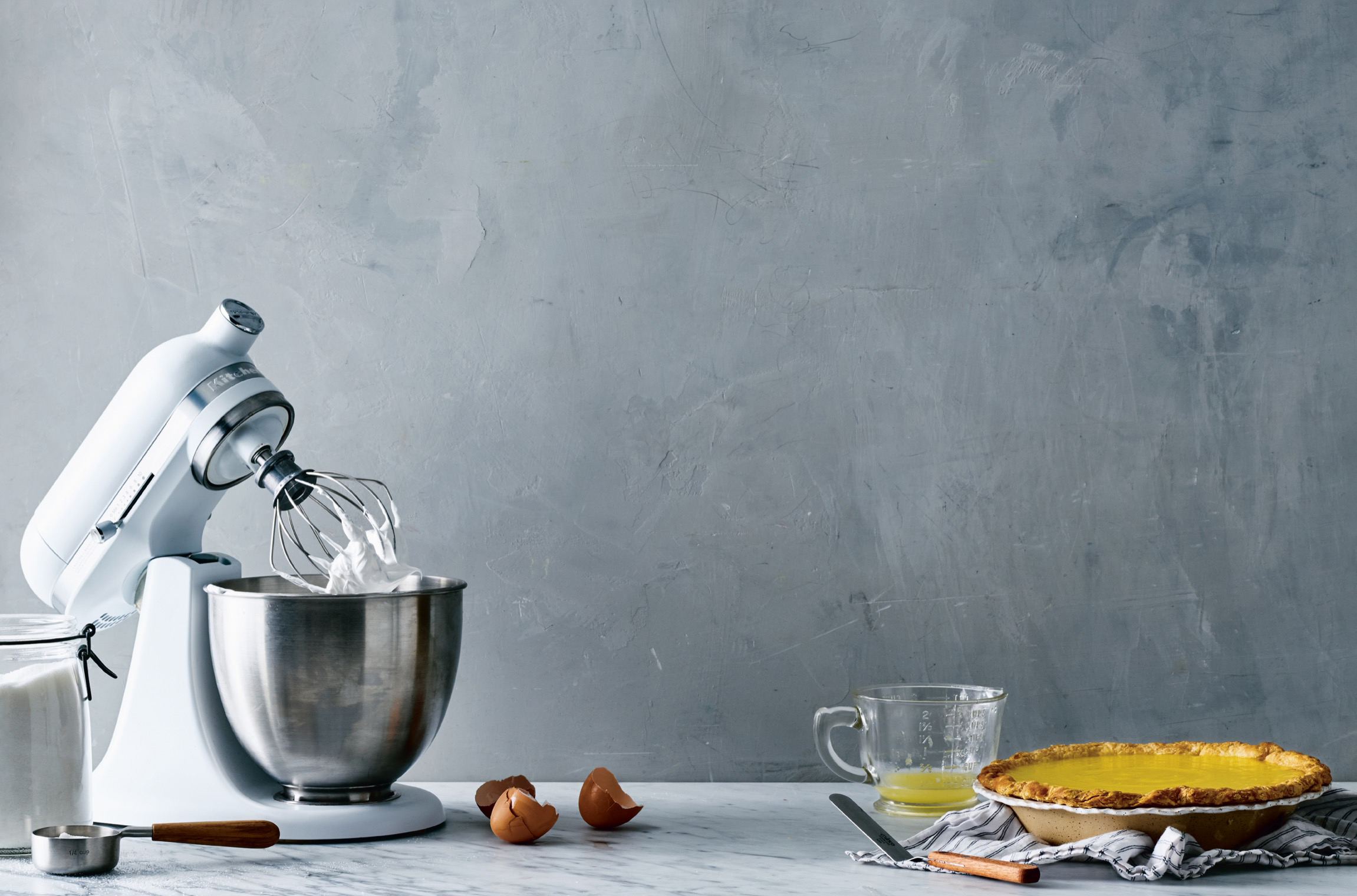
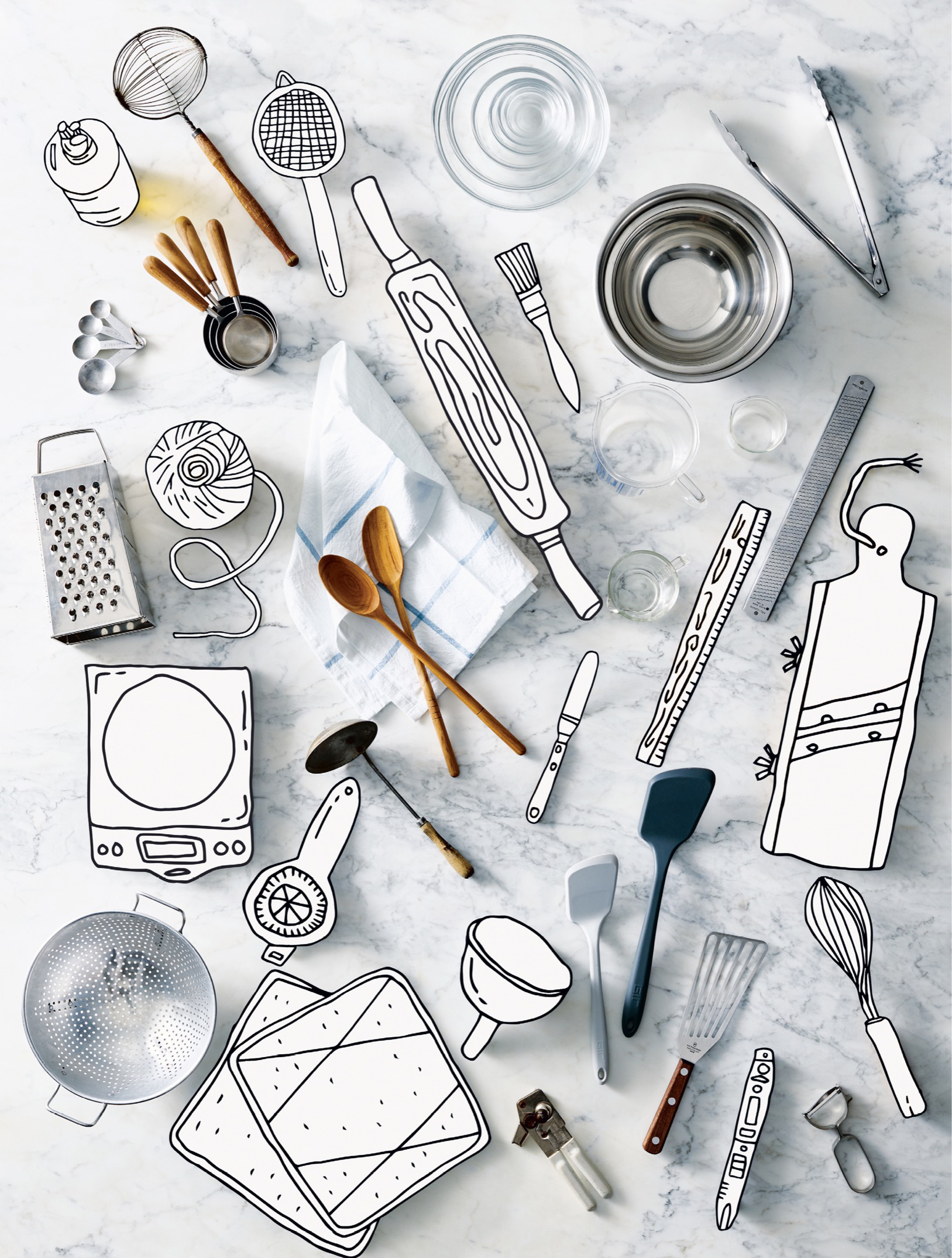
The Little Things
These are the oft-reached-for tools that sit proudly in a crock, stoveside, or are nestled in the drawer nearest our prep station. As a general rule, simpler tends to be better with these essential friends. We generally steer clear of single-use tools—but everyone’s got their favorite gadgets. If you use it and love it, keep it. (Psst: Check out Your Kitchen Cheat Sheet on this page for any measurement conversions you may need.)
Must-Haves

-
Box grater: Look for one with a no-slip base, an easily grippable handle, and a sharp stainless-steel grating surface on each of its four to six distinct sides. It should tackle the hard (potatoes) and the soft (mozzarella) equally well.
-
Can opener: We like a basic model (no magnets or special tricks) with a large turning knob and ergonomic handles.
-
Colander: Smaller holes make it as good for draining grains and pasta as for washing vegetables. Plastic and metal versions both work great.
-
Dry measuring cups: Whether made of metal or plastic, pick a set with ¼ cup, ⅓ cup, ½ cup, and 1 cup measures.
-
Fish spatula: Typically made of stainless steel, its thin edge slides under lots more than fish—delicate fried eggs, tender all-beef patties, cheesy fritters, and more.
-
Kitchen towels: We’re faithful to large, lint-free, quick-drying cotton flour-sack towels. A couple of thicker, extra-absorbent utility towels round out the pack.
-
Ladle: Get a roomy one made of stainless steel, and soup’s on. (Rum punch, too!)
-
Liquid measuring cups: One 4-cup measure and one 1-cup measure are all you need. We like ones made of glass.
-
Measuring spoons: Decorative sets are cute, but not as accurate as classic stainless- steel or plastic spoons.
-
Mixing and prep bowls: A stainless-steel or glass nesting set of three is all you’ll need for prepping, mixing, and serving.
-
Peeler: We’ll happily use a straight or Y-shaped peeler with a plastic or stainless-steel handle, as long as it feels good to hold and the blade is sturdy and sharp.
-
Pepper mill: We prefer fresh-ground pepper over preground any day of the week! Pick whatever design you like best but make sure it’s easy to refill.
-
Rasp-style grater: You might know this as a Microplane. We love it for finely zesting citrus, grating garlic to a paste, and piling fluffy banks of Parmesan on pasta.
-
Silicone spatulas: Get one large and one small, ideally without a detachable head (which can come apart easily and trap bits of food and bacteria inside).
-
Spider or slotted spoon: For lifting just-boiled eggs and crisp-fried falafel from the pot, you can’t go wrong with a metal variety, which won’t melt—unlike the plastic versions.
-
Tongs: For turning steaks and tossing greens, look for a stainless-steel set with a strong, steady grip. A collapsing and locking feature allows for convenient storage, but isn’t a “must.”
-
Wooden spoons: We’d be lost without at least two, one with a bowl for tasting and one with a flat edge for scraping.
Nice-to-Haves

-
¼-cup liquid measure: For the precision-minded, a glass mini measuring cup delineates tablespoons, teaspoons, and ounces.
-
Apron: It’s got us covered in the kitchen.
-
Citrus reamer: The perfect tool for getting every last drop of juice. We like the simple wooden style.
-
Corkscrew: For bottles of red and white, we prefer simple folding “waiter’s friend” models over the ones with “arms.”
-
Digital scale: For super-exact measuring in your cooking and baking.
-
Fine-mesh sieve: This strainer produces silky-smooth purées and sauces.
-
Funnel: A thin-mouthed one is great for decanting olive oil from jug to cruet (see “oil cruet” entry), and a wide-mouthed model can help dried goods go easily into jars. Stainless-steel or plastic types both work great.
-
Instant-read thermometer: With this helpful tool, you’ll never undercook meat or bread again. Though thermometers can range quite a bit in cost and quality, we prefer an inexpensive to middle-of-the-road model. What matters most is a quick and accurate temperature measure (3 to 5 seconds), sturdy build, long probe length, and an easy-to-read dial.
-
Kitchen twine: Get a ball (food-grade or made of 100 percent cotton) for tying roasts and making herb bundles.
-
Mandoline: Spring for a thin, flat, Japanese-style model with a sharp stainless-steel blade and a hand guard. (Watch your fingers!)
-
Mini offset spatula: A cookie-lifting, mayo-spreading, and cake-frosting dynamo made of stainless steel.
-
Oil cruet: This dispenser is easier to hold and maneuver than a giant can of olive oil. There are handsome options made of dark glass or stoneware.
-
Pastry brush: The old-school version—an actual wooden-handled paintbrush—does the job beautifully. Silicone models with an attached head are good options, too, especially for basting barbecued meats with glaze and brushing egg wash onto delicate pastries.
-
Pot holders: We love these for handling hot pots or doubling as a trivet, but folded (and bone-dry!) dish towels are easy, always-in-reach substitutes.
-
Rolling pin: Not just for pies, rolling pins are great for tenderizing meat or crushing graham crackers. Lightweight, easy-to-clean wood is the way to go.
-
Ruler: Sure, we can eyeball with the best of ’em—but knowing for sure means getting just the right thickness on a rolled-out crust (soggy bottoms no more!).
-
Salt cellar: Choose something on the bigger side, so you’re not always topping it off.
-
Whisk: Stainless-steel or silicone balloon whisks are your best bet. But unless you whip a lot of cream or egg whites, you can get by with a fork just fine.
Equipment Swaps:How to MacGyver Your Way to a Meal
You’ve gotten excited about a new recipe and then realized that—drat!—you don’t have the necessary tools. But it’s no reason to give up! See if you can get the job done with what you have.
No apron? A clean kitchen towel tucked around the waist is a fine stand-in.
No citrus reamer? Twist the tines of a fork into a halved fruit’s flesh, and squeeze.
No fine-mesh sieve? Layer a thin, clean kitchen towel over a colander to strain.
No food processor? Use your blender. Most blenders can handle a pesto or purée—but a blender can’t chop things up. For that, try using a rolling pin to bash cookies or nuts to crumbs in a ziplock or silicone bag.
No pastry brush? Distribute an egg wash or glaze with your best tools: hands.
No potato masher? Grab a whisk and mash away at those creamy potatoes.
No rolling pin? Track down a wine bottle (just give it a quick rinse beforehand).
No sifter? Add your ingredients to a fine-mesh sieve and shake the sieve to sift.
No stand or handheld electric mixer? For a simple creaming of sugar into butter, a wooden spoon and some elbow grease make a good sub.
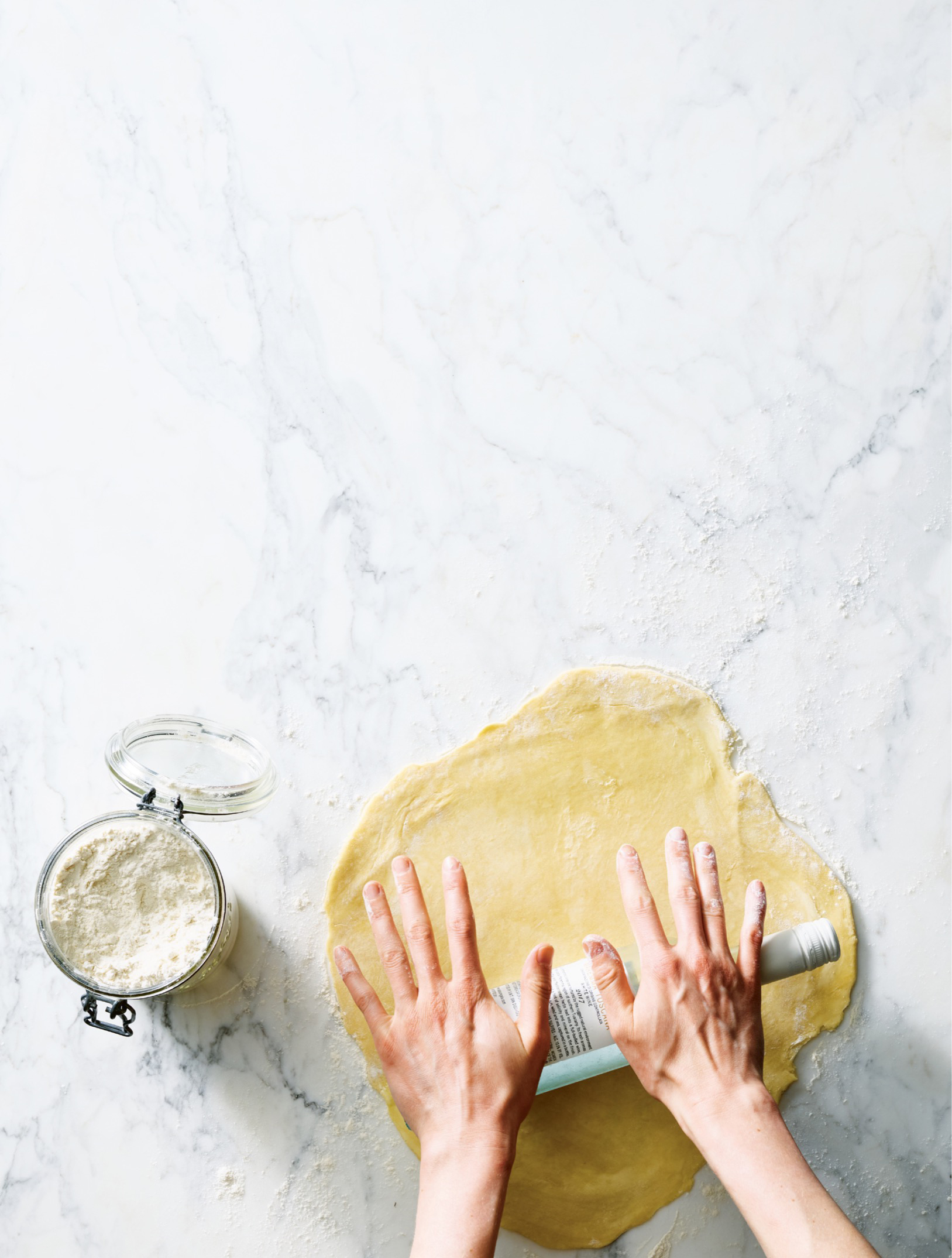
The Tools Our Test Kitchen Can’t Cook Without
Josh Cohen is Food52’s former test kitchen director and our current chef-in-residence. For years, he was in charge of the food for our in-house photo shoots, and responsible for managing our test kitchen’s always-full fridge and pantry (among other things). We asked him about the tools he reaches for most.
Q What are your most-used (and most-beloved) kitchen prep tools?
A A sharp 8-inch chef’s knife is the first tool I grab every day at work. Besides that, I use a wooden spoon, rubber spatula, Microplane, tongs, Y-shaped vegetable peeler, and fish spatula. But my best-loved items are all related to pasta: a hand-crank roller I’ve owned for more than 10 years, a chitarra for cutting long strands, and a gnocchi board for creating those little ridges.
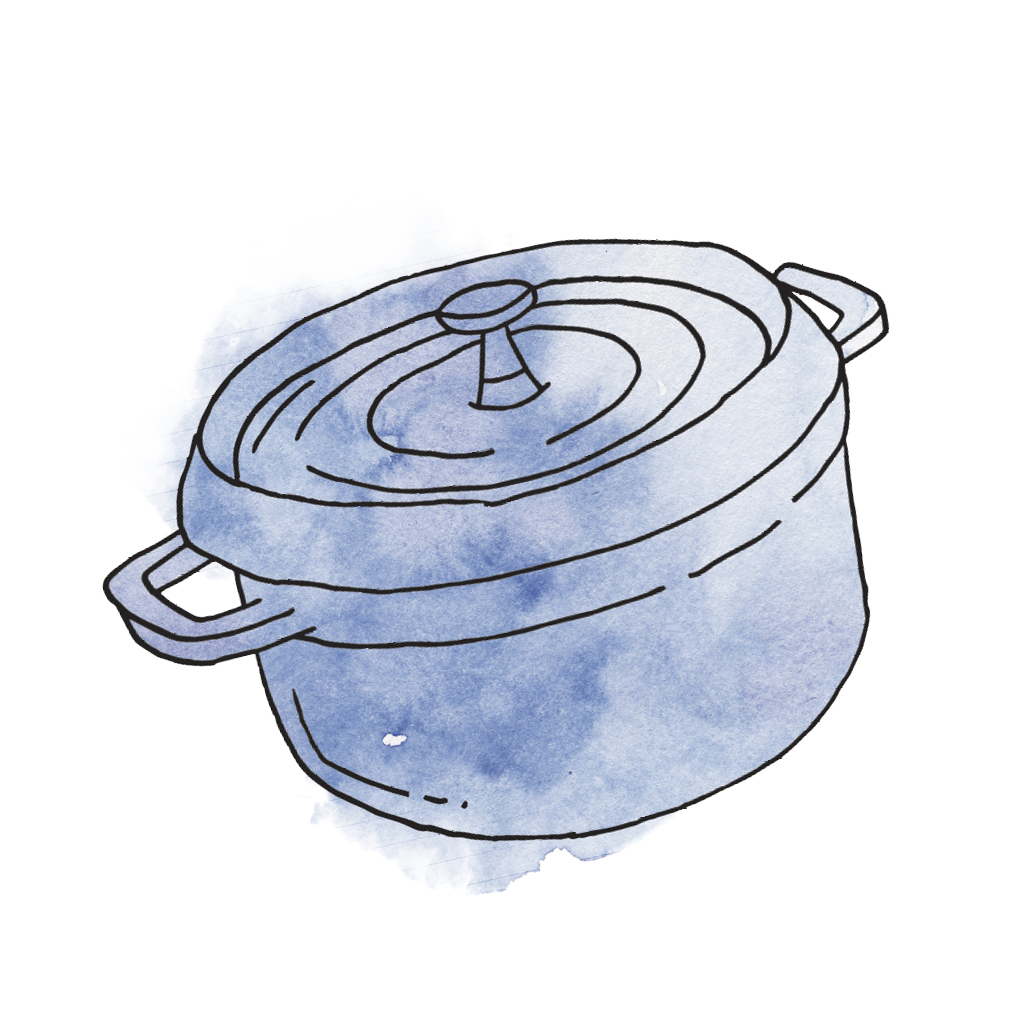
Q What can’t you imagine cooking without?
A A large cutting board. I hate trying to chop something on a small board because food ends up falling off the board and onto the floor. I also like to have a large stockpot or Dutch oven and a large skillet (overcrowding a pan is a no-go). My favorite item, by far, is a cast-iron skillet by the maker Smithey. It’s a heavy-duty pan for searing, and it also becomes nonstick the more you use it and take care of it.
Q Which small prep tool has been the biggest game changer for you?
A A mini offset spatula is always useful to have. For any recipe that requires some finesse—from smoothing a batter to working with frosting—it’s my very best friend.

Q What was your first kitchen-related investment piece?
A An 8-inch chef’s knife and a whetstone. A good stone is important to maintaining your blade. And I would’ve bought a high-speed blender, but my wife already had a Vitamix blender when we started dating—that was a huge windfall!

Q Do you have a soft spot for any single-use kitchen gadgets?
A Nope. I have a Japanese mandoline that I love, and a mortar and pestle that isn’t totally necessary, but I like it. I try to be a minimalist.

Q What’s on your kitchen wish list?
A I am very happy—I have most everything I need. Although, I guess it would be fun to own a corzetti stamp (more pasta tools!).
Q What’s your favorite spot to shop for tools?
A Chef supplier JB Prince is a great store.

 FOR COOKING, BAKING & OTHER KITCHEN WIZARDRY
FOR COOKING, BAKING & OTHER KITCHEN WIZARDRY
Pots & Pans: Our Bread & Butter
You don’t need a lot of pots and pans to get the job done, but having a range of shapes and sizes opens the door to a world of new recipes. These are the ones we reach for on the daily. (Psst: Check out Your Kitchen Cheat Sheet on this page for any measurement conversions you may need.)
Must-Haves

-
2- and 4-quart lidded saucepans: You’ll want one of each size. Look for a heavy version to help avoid scorching, with a comfortable, long handle that conducts very little concentrated heat and remains cooler on the stove. We like stainless steel or carbon steel.
-
5- to 7-quart Dutch oven: This is your soup pot, braise pot, bean pot, and bread oven. Pick a heavyweight enameled one with a light-colored interior (to see what’s going on in there as you cook) and a pretty outer color (so you can serve straight from it).
-
8-quart lidded stockpot: Break this out for pasta night and to make chicken broth. You only need one, so make sure it’s a hefty, strong-bottomed stainless-steel model with a well-fitting lid.
-
8- and 10-inch frying pans: Buy one of each for all your searing, sizzling, and frying needs. Stainless steel or carbon steel work best—but at least one should be nonstick (see this page). A well-fitting lid’s a nice-to-have.
-
10- to 12-inch cast-iron skillet: We can barely imagine cooking without one. Take care of it well for a nearly nonstick surface (see this page to learn how).
Nice-to-Haves

-
½- to 1-quart butter warmer: For boiling two eggs, warming milk for cocoa, or, ahem, melting a stick of butter, choose an enameled or stainless-steel pot with a lid.
-
1½-quart rice pot: It’s designed to cook rice perfectly, but it can make lots of other stove-top cameos (like poaching eggs or making oatmeal for two). Enamel is our preference, and lidded.
-
14-inch wok: Carbon steel can get screaming hot and is naturally nonstick. This roomy size gives you plenty of space to stir-fry your heart out.
-
Casserole dish: You’ll want one of these in oven-safe stoneware if you love baked mac and cheese or apple crisp. A pretty one you can serve in is a big plus.
-
Griddle/grill pan: Pick a carbon-steel or cast-iron model that lies directly over your stove’s burners. A reversible pan—with a smooth griddle on one side and grill pan grates on the other—is even better for smaller kitchens. Enjoy those burgers!
-
Roasting pan: Stainless steel is nearly indestructible, but enamel-coated is easiest to clean. A model with an insert rack is a nice-to-have, especially if you’re in charge of this year’s Thanksgiving turkey.
-
Steamer: For steaming vegetables, dumplings, and tender fish fillets galore, choose a folding stainless-steel or rigid bamboo version, equally good in our book.
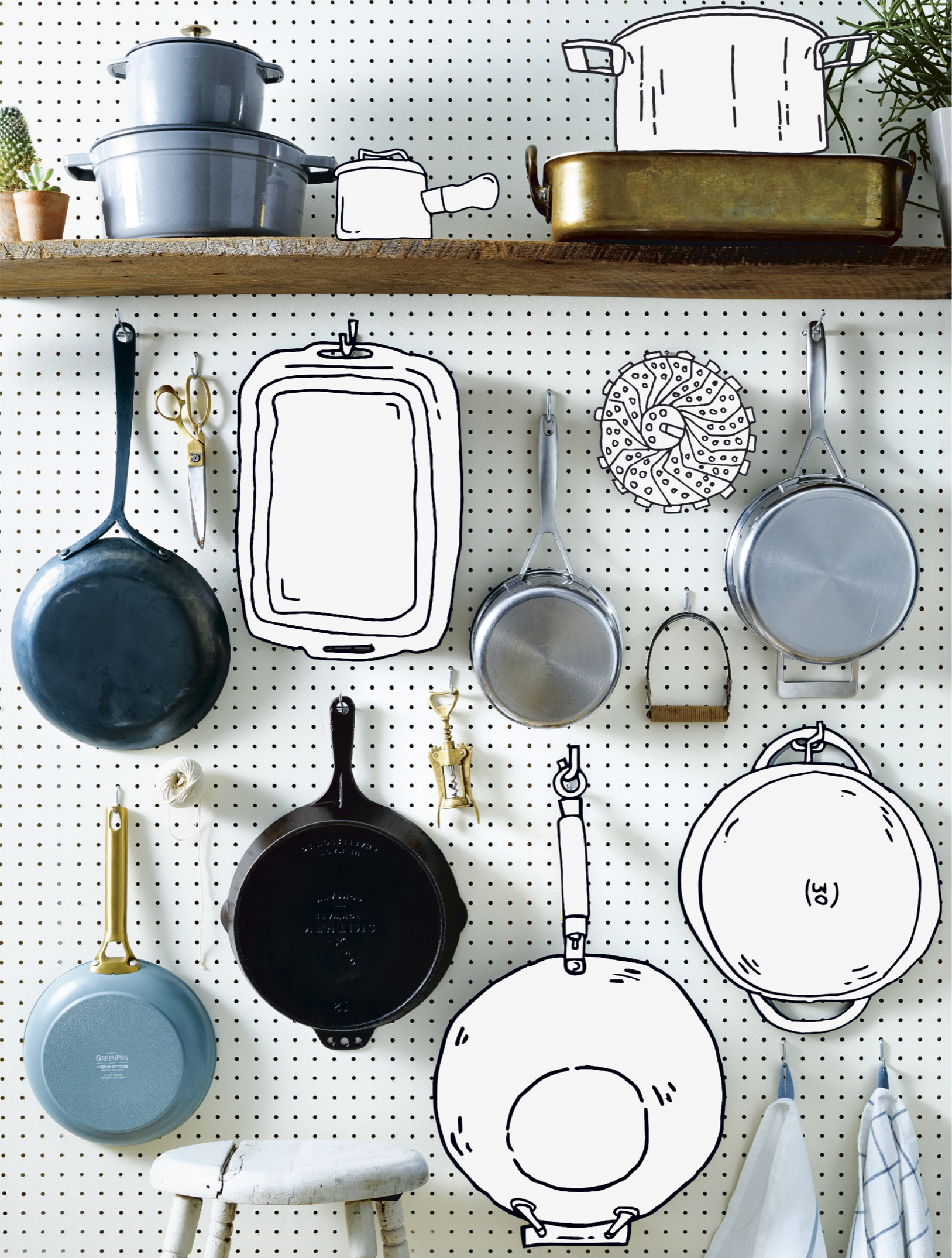
How to Take a Cast-Iron Pan from Rusty to Ready (& Keep It That Way)
Cast-iron pans aren’t just ultra-utilitarian—often passed down from cook to cook, they’re storytellers, too. They’ve got an unfair reputation for being high maintenance, but, really, cooking with a cast-iron pan is like keeping a guitar in tune: Give it a little attention here and there, and it sings. No matter in what condition your pan comes to you, it can likely be salvaged with these simple steps. Repeat them whenever it’s looking lackluster.

-
Heat the oven to 400°F. Sprinkle your pan generously with coarse salt (like kosher) and then use a halved potato, cut-side down, to scrub the salt all over. The salt will start to look pretty gross.
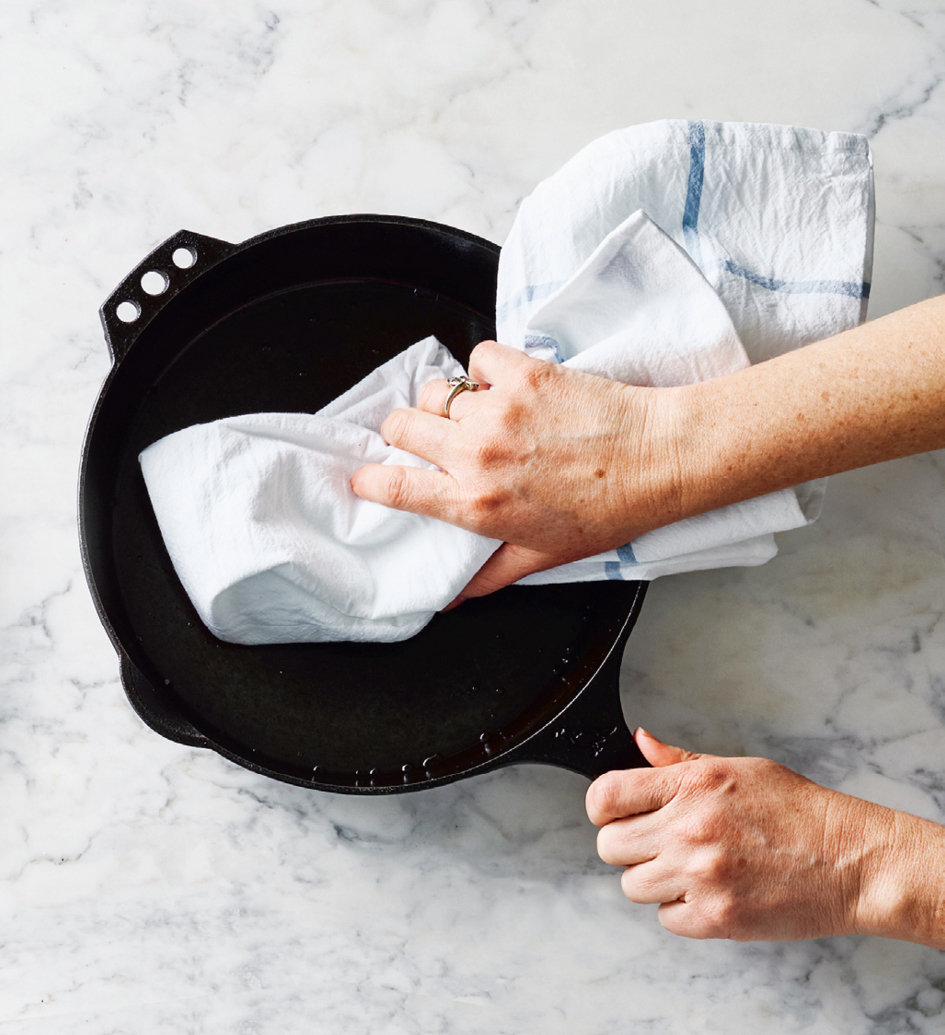
-
Rinse with water and dry well.

-
Swirl a few teaspoons of neutral oil (like canola) all around the pan to form a very thin coating, and pop the pan into the hot oven for an hour.

-
Carefully remove the pan from the oven and wipe out any remaining oil. You’re ready to cook!
Nonstick Pans: The Good, the Bad, the Ugly
Nonstick pans…rock! We love using them to make crispy fried rice, sear chicken breasts—you name it. But they’re worth researching because many of them get their nonstickiness from harsh chemicals. Track down a pan that is naturally nonstick (like ceramic-coated or carbon steel) or otherwise free of PFA, PFOA, and PFTE (aka Teflon, a chemical often found in nonstick cookware). When you find a type you like, get two of them; use them both with nonmetal utensils, and wash gently. Avoid nonstick bakeware, most of which hasn’t yet gotten the nontoxic treatment.
And if your nonstick pan ever peels, flakes, or scratches, toss it—you don’t want that stuff in your beautiful sunny-side-up eggs.

Bakeware: Oven & Out
Baking may require some special tools, but having just a few of them in your kitchen will totally change your game: special-occasion cakes, morning muffins, and gooey-in-the-middle cookies can all be yours. Our baking’s all the better with these essentials. (Psst: Check out Your Kitchen Cheat Sheet on this page for any measurement conversions you may need.)
Must-Haves

-
9 by 13-inch baking pan: Glass, ceramic, or metal (aluminum or stainless steel) all function the same—your call! Fruit buckles, enchiladas, and baked pastas all fit well in here.
-
Loaf pans: For banana bread and meat loaf alike, you’ll want two matching 8 by 4-inch or 9 by 5-inch aluminum or stainless-steel pans; recipes often yield two loaves.
-
Muffin tin: We recommend aluminum or stainless steel but not nonstick (that’s what muffin liners or just a good greasing is for). Pick one with a dozen cups.
-
Oven thermometer: This is a $5 tool for better, more accurate baking. Its tight-fitting hinges or hooks clip onto an oven rack and stay put.
-
Parchment paper: Use it for lining pans, wrapping treats for friends, and catching drips when you glaze a cake. Frankly, we couldn’t bake without it.
-
Rimmed sheet pans: Stock at least two of these in stainless steel or aluminum. “Half sheets” (18 by 13 inches) are our most-reached-for size to roast veggies, bake snickerdoodles, and corral ingredients into place before starting a recipe. “Quarter sheets” (9 by 13 inches) are great for smaller jobs, like roasting a handful of walnuts.
-
Round cake pans: Stock two aluminum or stainless-steel pans 9 inches in diameter and 2 inches deep, and you’re on your way to many a layer cake.
-
Spring-loaded scooper: These come in a range of sizes and easily scoop rounds of cookie dough, meatball mix, or perfectly portioned muffin batter.
-
Square cake pan: Look for an 8-inch or 9-inch pan in aluminum, stainless steel, or glass that’s at least 2 inches deep. Lemon bars, blondies, and cheesy cornbread have a happy home here.
-
Wire cooling rack: The more air that can circulate around your baked goods, the more evenly they’ll cool—and the sooner you can tear into them.
Nice-to-Haves

-
9-inch pie plate: A no-frills glass pie dish (the better to see the bottom of the pie!) is the most versatile.
-
9- to 10-inch springform pan: For cheesecakes and anything else that needs a high-sided pan, aluminum or stainless-steel versions are the way to go.
-
10- to 12-cup Bundt pan: For all of your old-school coffee-cake needs, choose a classic Bundt in either aluminum or stainless steel.
-
Bench scraper: Use it to scrape bits of ingredients from the counter or a mixing bowl, cut dough into pieces, or transfer chopped vegetables from cutting board to pan. We like it in stainless steel or plastic.
-
Cookie cutters: Strong, sharp, stainless-steel cutters will give you a clean slice. A set of graduated round cutters (straight or fluted) goes a long way.
-
Silicone sheet-pan liner: Sure, it’s pricier than parchment paper, but you’ll have it forever.
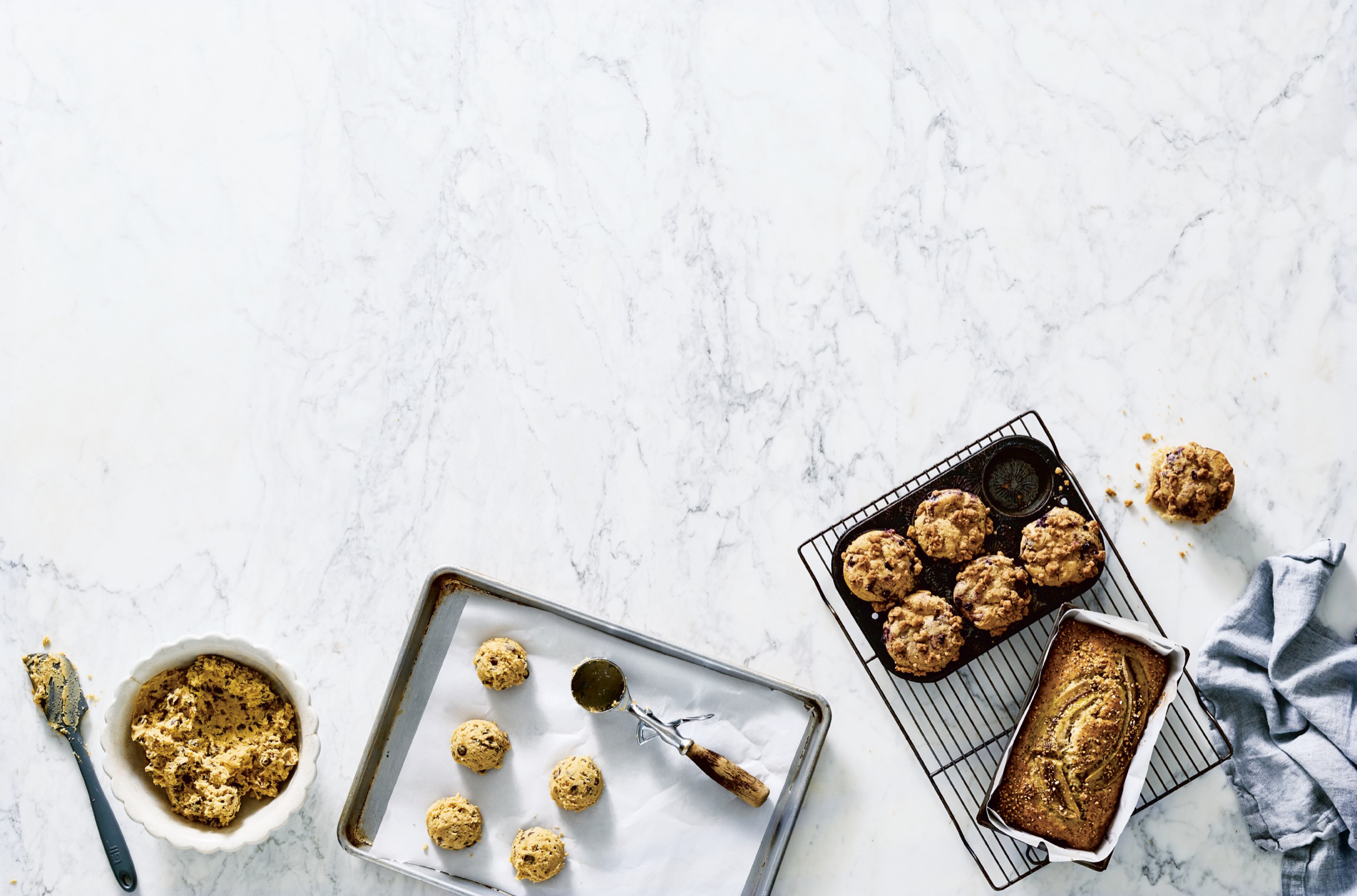
 FOR SERVING, SHARING & NIBBLING
FOR SERVING, SHARING & NIBBLING
Tableware: Your Dinner’s Handsome Canvas
As with all kitchen tools, we consider beauty and functionality when it comes to tableware. These items should be nice to look at but easily stackable, not too fragile, and most often dishwasher- and microwave-safe. Our shelves are filled with a mix of vintage china, new box-store models, and handmade beauties from ceramicists we love. We prefer fun mismatching sets, too, but in a streamlined palette to tie it all together. (Psst: Check out Your Kitchen Cheat Sheet on this page for any measurement conversions you may need.)
For Everyday Eating

-
Big plates: We’re talking dinner-size (10 to 12 inches in diameter).
-
Small plates: For apps, snacks, you name it (we like ones from 4 to 7 inches).
-
Big bowls: For stews, hearty salads, and more. You might also consider the ever-handy “blate,” aka a low, wide bowl.
-
Small bowls: Cereal, soup, and dips have a place in these.
-
Teensy bowls: For olives and their pits or a handful of bar nuts—the cuter the better! Stock as many as you want.
-
Tall glasses: For water and highballs.
-
Short glasses: For OJ with breakfast and wine at dinnertime.
-
Mugs: Mugs are superpersonal (weird but true!). Don’t let us cramp your style.
-
Utensils: Must be dishwasher-safe and nice to hold. Steak knives are great if you eat steak regularly, and you can also use them for chicken, burgers, and even thickly cut cauliflower or eggplant. (We keep one or two of these per person.)
-
Cloth napkins: They save paper and help set the scene.
For Parties & Crowds

-
Cake stand: For putting your cake/pie/fruit bowl on a pedestal.
-
Large serving bowls: Two will cover your pasta night and weekly fruit haul. We love ones in ceramic and wood.
-
Large serving utensils: You’ll need just two serving spoons to dish up the goods at your dinner party, one slotted and one solid; also, a large serving fork.
-
Pitcher: When it isn’t serving up drinks, it doubles as a vase.
-
Platters: Two is a good place to start. Get a mix of shapes and sizes, but make sure they’re heatproof (so you can keep plated food warm until you’re ready to serve) and easy to clean (nothing overly bulky, heavy, or ornate, please).
-
Serving board: To carve a turkey or build a killer charcuterie or cheese plate. (You can also use a big wooden cutting board for this.)
-
Tablecloths: One in a light neutral, and another in a dark and dramatic hue.
-
Trays: For breakfast in bed or creating a mini moveable bar, two standard trays—one medium and one large—are all you need.

A Field Guide to Food-Storage Containers
Whether you’re looking to save the last spoonfuls of Thanksgiving stuffing or house a week’s worth of roasted vegetables, you’ll need a collection of durable, versatile storage containers. We look for ones with the following features:
-
Made of clear glass, so you can peek at what’s inside, and forever bid farewell to smells and stains; clear heavy-duty plastic, which is featherlight, basically unbreakable, and easy to tote around; or food-safe stainless steel, which isn’t see-through or microwave-safe, but is dishwasher-safe, durable, and eco-friendly.
-
Spill-proof, dishwasher-safe, and microwave-safe; it’s simply practical.
-
Stackable bases with stackable lids to help avoid haphazard storage.
-
A variety of sizes for corralling your week’s meal prep.
Must-Haves

(Here’s a starter kit for a household of two; and check out Your Kitchen Cheat Sheet on this page for any measurement conversions you may need.)
-
Large containers (2 to 3): Choose 6- to 7-cup sizes for large amounts of leftovers.
-
Medium containers (5 to 7): These are the 2- to 4-cup containers for packing lunches, stashing smallish amounts of leftovers, and keeping meal-prep components in line.
-
Small containers (2 to 3): Little 1-cup bowls for the odd half-avocado or lemon, a batch of dip, or your morning yogurt.
-
Insulated thermos mug or bottle: One per person for coffee and tea on the go.
-
Reusable water bottle: One per person for water sipping. Stainless steel is the most durable, but we like glass bottles, too.
Nice-to-Haves

-
10- to 16-ounce insulated wide-mouth Thermos: Use for transporting (and keeping warm) soup, oatmeal, or your favorite stewy stroganoff.
-
Bento- or tiffin-style lunchbox: Their nifty compartments are a cinch to clean and keep wet foods separate from dry.
-
Very small containers: Pick anything between 1 ounce and ½ cup for salad dressing and to-go snacks.
Unnecessary-but-Lovable Unitaskers

-
Ceramic butter keeper: Once you’ve slathered perfectly spreadable butter on a crusty loaf, you’ll know why we swear by these little friends.
-
Cheese vault: Your cave-aged Gouda will stay funky and fresh. Look for a food-grade silicone model with an adjustable compartment size.
-
Wooden, melamine, or steel bread box: It keeps your loaves crisp-crusted and out of the way.

For Adding Some Comfy & Cozy
A kitchen needs to withstand some serious wear and tear—but that doesn’t mean everything has to be stainless steel and silicone. The delight is in the details, the not-necessarily-functional things that make a kitchen your kitchen. If walking into the kitchen makes you smile, you’ll want to spend more time in there.
Here Are a Few Ideas:

-
Taped-up love notes
-
A big vase of flowers to greet you
-
A cheerful rug to stand on
-
Hand-me-down tools, treasures, and recipe cards from the people who’ve cooked for you
-
Photos of the people for whom you most like to cook
-
Hook-hung vintage copper pots


 YOUR GAME PLAN
YOUR GAME PLAN
Paring Back: How to Know When Your Tools Have to Go
Okay, so you’ve gotten the lay of the land, and you’re filling up and settling into your kitchen. But if you’re anything like us, how and what you cook will change all the time, and so will your tools. It’s worth asking yourself these questions every few months.
-
What have I used—or not used—in the past year? If you haven’t picked up that tool recently, it might be worth donating. Our exception: the “big feast” items that you pull out every now and then for holidays and dinner parties.
-
What are my unnecessary duplicates? Unless otherwise noted in this chapter, you really only need one of each kitchen tool. So, next time you unearth your growing collection of Y-peelers, set your favorite one aside. Put the still-functional duplicate items in a bag to donate to a charity or to a friend starting their own kitchen.
-
What unitaskers can be replaced with a sharp knife or kitchen shears? Unless you use them often, chances are you don’t need that pizza cutter or ravioli roller, pretty as they might be. Consider sticking with the knife instead.
-
What’s out of shape? Dull-edged knives, sticky pans—these are the things that need 15 minutes of your (or a specialist’s) attention. If they’re truly broken or will cost more to fix than to replace, it’s probably time to clear them out.
-
What’s looking especially dated? These may be the things you use quite often but haven’t turned a critical eye to in a while. If they’re more than a little banged up or are operating less than perfectly, it might be time to upgrade. (Bonus: More modern tools and appliances are usually slimmer, not to mention more energy efficient.)
-
What kitchen tools make me smile? Of course, the preceding rules are just guidelines—if your two spice grinders are continually getting use and delighting you, go ahead and keep them both.
The Big Stock-Up: Our Tips for Shopping, Sourcing & Investing
Selecting a kitchen’s trappings is a careful dance: You’ll want to prioritize the tools that work well and reliably, are pleasing to use, and that won’t break the bank. Our favorite approach is to shop around at a mix of specialty kitchen stores (for beloved name brands), restaurant supply stores (for inexpensive, workaday basics), thrift stores (for secondhand greats), and more.
For more ideas about what to buy, head to the Sourcebook on this page.
-
Specialty kitchen stores (in person or online): Our favorite sources for quality kitchenware include OXO for small hand tools; KitchenAid, Cuisinart, and Breville for appliances, like mixers and food processors; Staub and Le Creuset for enameled pans and Dutch ovens; Smithey and Lodge for cast iron; GreenPan and Ballarini for nonstick pans; and Zwilling (specifically Demeyere) and All-Clad for 5-ply stainless-steel cookware. We also love Crate & Barrel and CB2 for tableware.
-
Restaurant supply stores: This is the place to stock up on sheet pans, thermometers, rolling pins, mixing bowls, some cookware (like woks), tongs, measuring cups and spoons, wooden spoons, and even knives. The equipment will be hardworking, frill-less, and inexpensive.
-
Thrift stores: Your local thrift store’s kitchen section is a treasure trove. You’ll find glass and metal baking pans galore, cast iron of all kinds, glass measuring cups, gently used appliances, and vintage dishware, flatware, and servingware aplenty—as well as Bundt pans. Thrift stores are rich in Bundt pans!
-
IKEA: Yep—our Swedish big-box friend gets a shout-out of its own. We’d be remiss not to sing the praises of IKEA’s basic kitchen towels (not even a dollar a pop!), plastic cutting boards, and affordable bamboo butcher blocks.
The Affordable Kitchen: Basics on a Budget
Buying tools for a kitchen can feel overwhelming, especially if you’re looking to save some money. But a small investment can go far—really far! Here’s a shopping list of our desert-island kitchen essentials, all for just a couple hundred bucks. Some guidelines: Shop at restaurant supply stores over specialty home and cooking stores, buy generic-brand tools, and compare prices of individual items versus prepackaged sets (sometimes, for example, three single mixing bowls can cost less than a nesting trio). Hit the thrift store or yard sales for perfectly good, preloved tools, and we bet you could do it even more affordably!
For the rest of our tool recommendations, head to this page (and check out Your Kitchen Cheat Sheet on this page for any measurement conversions you may need).
-
1-cup glass liquid measure for broths, marinades, and beyond.
-
3- to 5-quart aluminum-clad stainless-steel pot or saucepan with lid for boiling eggs and cooking rice.
-
8- to 12-quart aluminum-clad stainless-steel pot with lid for making soup and pasta and so much more.
-
8- to 10-inch cast-iron pan for frying eggs and baking cornbread.
-
Aluminum rimmed half-sheet pan for roasting vegetables and baking batches of cookies.
-
Chef’s knife for leading the way.
-
Large plastic cutting board to do all your chopping on (as big as you can find).
-
Medium- or fine-mesh stainless-steel or aluminum strainer for catching everything.
-
Silicone spatula for getting every last drop.
-
Stainless-steel or glass mixing bowls for mixing and serving (set of three).
-
Stainless-steel fish spatula for flipping burgers and lifting pancakes.
-
Stainless-steel measuring spoons for confident baking and seasoning.
-
Stainless-steel or plastic measuring cups for flour, grains, and beans.
-
Wooden spoon for stirring and stirring.
The Dreamboat Investments
With ingredients and tools, we try to buy the best we can afford. But there are some tools we can buy cheaply and cheerfully without sacrificing functionality, and others where craftsmanship, durability, and environmental concerns are worth extra consideration. For the later, shopping in a slightly higher price bracket changes the game entirely. If you can invest up to a few hundred dollars on each, these are the tools that are worth it.
-
Extra-large cutting board or butcher block: What’s the truest luxury in the kitchen? Room to spread out! A large, solid-wood cutting board is a worthwhile buy. John Boos makes near-indestructible ones in a variety of sizes; their boards that are 12 by 18 inches and 1½ inches thick start at about $70.
-
Handheld electric or stand mixer: If you love to bake, it’s hard to imagine going without one of these. Be sure to consider professionally refurbished models, which are good as new and much less expensive. You can find these online, either from the manufacturers themselves, electronics stores, or major online retailers; alternatively, look for secondhand items at thrift stores and yard sales. We love the classic KitchenAid mixers: new 7-speed handheld models are under $100; refurbished 5-quart stand mixers start at about $200; and new stand-mixer models range between $250 and $500.
-
Heavy enameled Dutch oven: Thick-walled, heat-retaining, beautiful, and all-purpose, you’ll use this pot forever. A 6-quart Lodge pot starts at about $60; a Staub of the same size starts at about $200; a Le Creuset version goes for about $350. Be sure to keep an eye out for the occasional sale on these, as the discounts can be big.
-
High-powered blenders: These hefty machines help us make all things smooth and silky—soups, smoothies, sauces, and the creamiest cashew cheese. Look for these refurbished, too, or at your neighborhood yard sale. At these places, you can even get ’em for about $200.
-
Knives: If $35 can get you a good knife and $50 can get you a great one, $100 to $150 will buy you a truly excellent one. Our test kitchen favors those from Zwilling J. A. Henckels, Opinel, and Miyabi.
-
Nontoxic nonstick pans: Nonstick pans aren’t terribly expensive, but it’s worth it to spend more on models free of certain chemicals (see this page for more on this). GreenPan and Ballarini both make beautiful, reliable ones—and you should be able to get a set of two for under $100.

Our Resident Genius
KRISTEN MIGLORE’S
Kitchen Kit
Kristen Miglore is Food52’s Genius Recipes excavator. She’s unearthed some of the most cherished dishes of our time from many a brilliant chef: the game-changers we know by heart. Kristen’s neat kitchen is where she cooks through them all. In addition to her must-have tools, it features potted plants, charming knickknacks, and favorite cookbooks in a hidden nook, so it’s always a place Kristen loves to be. Have a look-see into where she makes magic.
 I’ve always wanted Genius Recipes to be welcoming to all home cooks, so the recipes call for pretty minimal, basic equipment. I, myself, rely most on a big (but thin and lightweight) santoku knife.
I’ve always wanted Genius Recipes to be welcoming to all home cooks, so the recipes call for pretty minimal, basic equipment. I, myself, rely most on a big (but thin and lightweight) santoku knife.
 I cull my less-used tools regularly but do keep multiples of ones I use on repeat in a single cooking session (like kitchen shears, silicone spatulas, whisks, and wooden spoons), so I don’t have to wash them in between.
I cull my less-used tools regularly but do keep multiples of ones I use on repeat in a single cooking session (like kitchen shears, silicone spatulas, whisks, and wooden spoons), so I don’t have to wash them in between.
 The things I can’t cook without are a podcast and a decent speaker. (Putting my phone in a restaurant-supply quart container works as a sound-amplifying hack.)
The things I can’t cook without are a podcast and a decent speaker. (Putting my phone in a restaurant-supply quart container works as a sound-amplifying hack.)
 In my future dream kitchen, I hope to have a permanent island with a stove-top. For now, I’ve settled for a basic stainless-steel table from a restaurant supply store, where I can prep ingredients up top and house pots and pans below.
In my future dream kitchen, I hope to have a permanent island with a stove-top. For now, I’ve settled for a basic stainless-steel table from a restaurant supply store, where I can prep ingredients up top and house pots and pans below.


Recipe testing has forced me to be extra efficient with my space, storage, and (obsessive) cleanup habits to minimize chaos.
